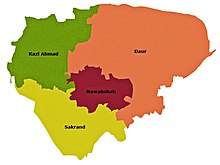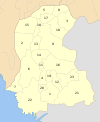|
Shaheed Benazirabad District
Shaheed Benazirabad District (Sindhi: شهيد بينظيرآباد ضلعو, Urdu: ضلع شہید بینظیر آباد) previously known as Nawabshah District, is one of the districts in the province of Sindh, Pakistan. RenamingThe district was renamed in September 2008 when most of MPAs of Nawabshah demanded the district be renamed to honour the late party leader.[2] The renaming of the district was criticised by the family of Syed Nawabshah and others who, while saddened at the death of Bhutto, felt that Nawabshah was a historic district and ought to have kept its name.[2] HistoryAt the establishment of the district on 1 November 1912, seven talukas were included in this district: The district was divided into two Sub-divisions, namely Nawabshah Sub-division and Naushahro Feroze Sub-division. The former comprised the three talukas Shahdadpur, Sinjhoro and Nawabshah, while the later comprise the four talukas of Kandiaro, Naushahro Feroze, Moro and Sakrand. In 1953 the talukas of Shahdadpur and Sinjhoro became part of the newly established Sanghar District. This left Nawabshah Sub-division with only one taluka, so Sakrand taluka was moved from Naushahro Feroze Sub-division to Nawabshah Sub-division. In 1989, another part of the district, the talukas of Nausehro Feroz, Kandiaro and half of the taluka of Moro, was cleaved from it to form the new Naushahro Feroze District.[3] A new taluka, Daulatpur, was created, from half of the Moro and some of Sakrand taluka in Nawabshah district. The district then contained three talukas: In 2005, after the local government election, a new taluka named Daur was cleaved from Nawabshah taluka and Daulatpur taluka renamed to Kazi Ahmed. The district then comprised four talukas:
In May 2014, a 5.0 magnitude earthquake struck the district, killing one person and injuring 70.[4] Administrative Shaheed Benazir Abad formerly Nawabshah District. The Deputy Commissioner is responsible for overall administration of the district. Miss Kanwal Nizam Shaikh is currently the Deputy Commissioner of Shaheed Benazirabad since May 2023. She is the first female officer in history of Shaheed Benazirabad to serve as DC. The district is sub-divided into four Tehsils: Demographics
As of the 2023 census, Shaheed Benazirabad district has 334,356 households and a population of 1,845,102.[6] The district has a sex ratio of 103.18 males to 100 females and a literacy rate of 50.86%: 61.07% for males and 40.29% for females.[1][7] 606,305 (32.87% of the surveyed population) are under 10 years of age.[8] 598,120 (32.42%) live in urban areas.[1]
The majority religion is Islam, with 95.05% of the population. Hinduism (including those from Scheduled Castes) is practiced by 4.49% of the population. Members of other religions were mostly Christians, who mostly live in Nawabshah city.[9] At the time of the 2023 census, 85.2% of the population spoke Sindhi, 6.17% Urdu, 3.63% Punjabi, 1.64% Brahui and 1.57% Balochi as their first language.[12] EducationDistrict Shaheed Benazirabad is ranked at the 125th position in the education score index of the Pakistan District Education Rankings 2017 published by Alif Ailaan.[citation needed] Low learning outcome issues remain a hindrance for district Shaheed Benazirabad. Issues reported by the residents via the Taleem Do! App complain of the lack of primary schools in the area. The debate on whether basic education should be provided in the regional, national or official languages has been a point of debate in Pakistan for several years.[citation needed] EventsThe H. M. Khoja Annual Flower Show was introduced by H. M. Khoja in 1954 at Khoja Garden. The celebrations take place for three or four days.[13] Major educational institutesEducational institutions in district Benazirabad include: Universities
Colleges
Major Health Centres
Union CouncilsThere are 62 Union Councils in Shaheed Benazirabad District: Union Councils are given below:
List of DehsThe following is a list of Dadu District's 351 dehs, organised by taluka:[14]
See also
References
Notes
Sources
|
|||||||||||||||||||||||||||||||||||||||||||||||||||||||||||||||||||||||||||||||||||||||||||||||||||||||||||||||||||||||||||||||||||||||||||||||||||||||||||||||
Portal di Ensiklopedia Dunia


